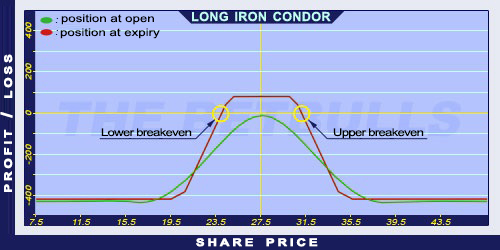Description and use
Long Iron Condor option strategy can be profitable if the underlying’s price increases or moves within given levels. It is basically a combination of a Bull Put Spread and a Bear Call Spread, but it can be also seen as a version of a Long Iron Butterfly. The strike of the higher Put is lower than the strike of the lower Call. This makes the options form a condor shape. The combination of two income strategies result another income strategy. Ideally, the share price closes between the middle components strike prices, which maximises the profit. In this case the options can expire and the investor can keep the combined credit. The range of the breakeven points are wider due to the Bull Put - Bear Call combination. The direction of the market is neutral. The investor speculates on shares with low volatility and small price changes. The strategy is a net credit investment. It is a short-term investment, usually one month or less.
- Type: Neutral
- Transaction type: Credit
- Maximum profit: Limited
- Maximum loss: Limited
- Strategy: Income strategy, Neutral strategy
Opening the position
- Buy a lower strike (OTM) Put option.
- Sell a middle lower strike (OTM) Put option.
- Sell a middle higher strike (OTM) Call option.
- Buy a higher strike (OTM) Call option.
- All components have the same expiration. The strategy uses both Call and Put options. The difference between consecutive strike prices must be equal.
Steps
Entry:
- Make sure the share prices are moving within certain limits.
Exit:
- The position can be closed before expiration. The commissions should not be forgotten during calculations.
Basic characteristics
Maximum loss: Difference between consecutive strike prices - net credit.
Maximum profit: Received net credit.
Time decay: Time decay has a positive effect on the value when the position is profitable, and a negative effect when the position is lossmaking.
Lower breakeven point: Middle Short Put’s strike price - Net Credit.
Upper breakeven point: Middle Short Call’s strike price + Net Credit.
Advantages and disadvantages
Advantages:
- The investor can profit from share prices moving within given limits.
- Low and limited risk with potential income.
Disadvantages:
- Potentially higher profit is only possible close to expiration.
Closing the position
Closing the position:
- Buy back the Short options and sell the Long options.
Mitigation of losses:
- Close the position the above-mentioned way.
Example
ABCD is traded for $27.50 on 12.04.2017. The investor buys a Long Put option which has a strike price of $20.00, expires in May 2017. and costs $0.25 (premium). Then he sells a Short Put option which has a strike price of $25.00, expires in May 2017. and costs $1.25 (premium). Then sells a Short Call option which has a strike price of $30.00, expires in May 2017. and costs $1.30 (premium). Finally, buys a Long Call option which has a strike price of $35.00, expires in May 2017. and costs $0.35 (premium).
Price of the underlying (share price): S= $27.50
Premium (Long Put): LP= $0.25
Premium (Short Put): SP= $1.25
Premium (Long Call): LC= $0.35
Premium (Short Call): SC= $1.30
Strike price (Long Put): KLP= $20.00
Strike price (Short Put): KSP= $25.00
Strike price (Long Call): KLC= $30.00
Strike price (Short Call): KSC=$35.00
Net credit: NCr
Maximum loss: R
Maximum profit: Pr
Lower breakeven point: LBEP
Upper breakeven point: UBEP
Net credit: NCr = (LP + LC) - (SP + SC)
Maximum loss (risk): R = (KSP - KLP) - NCr or R = (KSC - KLP) - NCr or R = (KLC - KSC) - NCr
Maximum profit: Pr = NCr
Lower breakeven point: LBEP = KSP - NCr
Upper breakeven point: UBEP = KSC + NCr
NCr = $1.95
R = $3.05
Pr = $1.95
LBEP = $23.05
UBEP = $31.95














